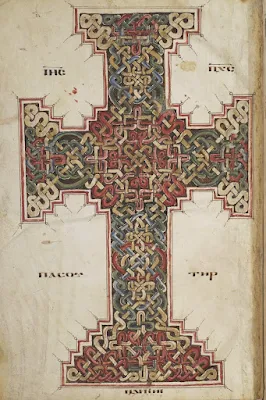Last month, I posted pictures of a twelfth-century Coptic Gospel book which I happened to stumble across on the website of the Bibliothèque Nationale de France. (Département des Manuscrits. Copte 13) Even though the see of Alexandria was founded by St Mark the Evangelist, there is a much higher concentration of illustrations in the Gospel of St Matthew than in the other three, so here are the images from Mark and Luke. This is just a selection, and I have cropped the pages to highlight just the illustrations.
Each Gospel is preceded by one of these elaborated decorated crosses; the Coptic letters around it (with abbreviation marks over them at top) mean “Jesus Christ, the Savior of the world.” The Coptic alphabet is the same as the Greek alphabet, with seven letters based on late demotic Egyptian script to represent sounds for which Greek has no letter. The language also borrows a huge number of words from Greek, as for example “souter - savior”, from the Greek “soter.”
The beginning of the Gospel; that of Luke as both of these elements as well, but they are almost perfectly identical to these from Mark, and are not included below.
The first illustration does not occur until chapter 6, the beheading of John the Baptist; St Mark gives the most complete account of this, and is consequently read on the feast on August 29th in most liturgical traditions, even those like the Roman Rite which otherwise make fairly little use of him.
The very last page has this large colophon in Greek that says, “The Gospel of life, in peace to the...” (and then I must confess that I am uncertain what the abbreviated words that follow mean.)
The beginning of the Gospel; that of Luke as both of these elements as well, but they are almost perfectly identical to these from Mark, and are not included below.
The first illustration does not occur until chapter 6, the beheading of John the Baptist; St Mark gives the most complete account of this, and is consequently read on the feast on August 29th in most liturgical traditions, even those like the Roman Rite which otherwise make fairly little use of him.
The healing of the blind man at Bethsaida in chapter 7.
At the very end of the Gospel, Joseph of Arimathea goes to Pilate to ask for the body of Christ.The very last page has this large colophon in Greek that says, “The Gospel of life, in peace to the...” (and then I must confess that I am uncertain what the abbreviated words that follow mean.)
From the Gospel of St Luke, the Annunciation to Zacharias.
The Annunciation to Mary.
The Visitation
The agitation of the whole world going to be counted in the census proclaim by the Emperor Augustus, a recounted at the beginning of chapter 2. The Birth of Christ
The Presentation in the Temple
Christ among the Doctors
The beginning of the Genealogy according to Luke, the second half of chapter 3.
Christ receives the scroll in the synagogue at Capharnaum
The healing of the paralytic (chapter 5)
Peter, James and John adore the Lord after the Transfiguration.
The calling of Zacchaeus (chapter 19)
Peter and John at the Empty Tomb
The women meet the Angel at the tomb.
Christ meets the Disciples on the road to Emmaus
The Ascension, as recounted at the very end of Luke’s Gospel.























